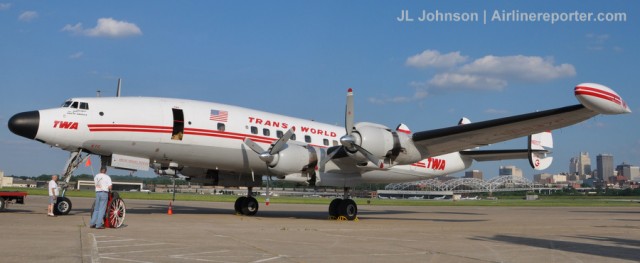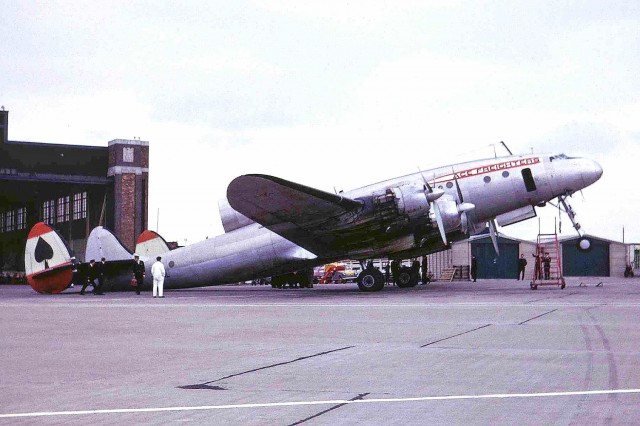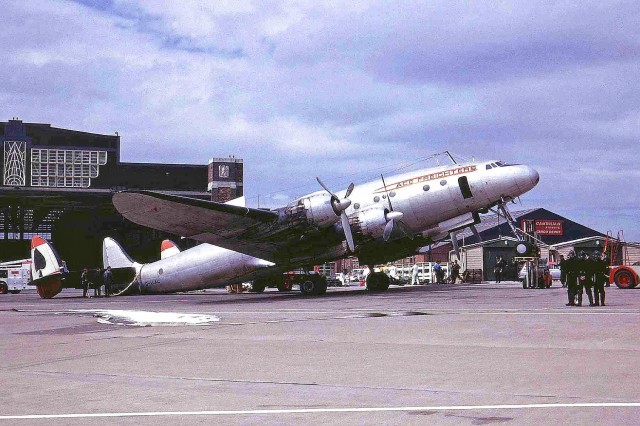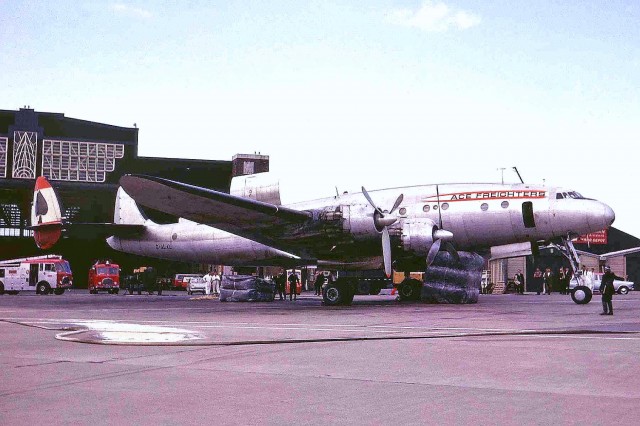
The Star of America, seen at the Kansas City Downtown Airport preparing for engine runs – Photo: JL Johnson
This is the story of a Connie that no one wanted, a plane that was abandoned and mothballed numerous times throughout its history. While it has had a generally-tragic existence, with just a few bright spots sprinkled in, this is an adventure that continues to unfold. In fact, in 2014, this plane will begin a new chapter as it again returns to the skies.
In 1958, this Lockheed Constellation rolled off the assembly line in Burbank, California – destined straight for storage. It was the beginning of the jet age and suddenly airlines had little interest in these sleek, evolutionary, once record-setting birds. Indeed, even those like this 1049H model, which were built with the intent of easy conversion between freighter and passenger configurations, were a hard sell. The variant was canceled after just over 50 were built, this example being third from last. Prior to completion, the order for this plane was canceled, just the beginning of a tough existence for this elegant flying machine.
In September of 1959 after over a year in storage, it was converted to freighter, sold to Slick Airways, and assigned registration number N6937C (which it has carried ever since). For eleven years the plane ran freight with various carriers before being stored and later abandoned in Miami, FL. In June of 1971, it was seized by the airport for non-payment of fees. After being auctioned off it spent the next four years doing odd jobs, hauling military parts and even horses. Its last commercial use was as a sprayer in Mesa, Arizona, where it was equipped with chemical tanks and large spray booms.

On July 2, 1966 this Lockheed Constellation (G-ALAL) had some weight issues. Click for larger. Photo by Ken Fielding.
Aviation enthusist Ken Fielding shared his photos with me about a Contellation in 1966 that had some weight issues and he was lucky enough to take some photos. Below are descriptions from Ken’s Flicker Account:
Oops!!! The ramp at the old Liverpool (LPL) terminal sloped away from the terminal quite sharply. This aircraft arrived from Belfast (BFS) with around 8,000kgs of cigarettes (although it was actually over 11,000kgs… but that’s another story!).
It was 3 tonnes overweight and also out of trim. I met it on arrival and as it stopped and they cut the engines, the nosewheel lifted about 6″ off the ground before slowly settling back on the ramp. I collected the loadsheet and as I walked back to the office I was wondering what would happen when the 4 crew got off the flight deck and our 6 hulking loaders jumped on the back to start the offload. At that moment there was a sickening crunch and thud and I turned round to see it on its tail.

Ropes are an interesting idea, but probably not going to work. Click for larger. Photo by Ken Fielding.
The idea here was to sling a rope over the tail with 6 loaders hanging on to it and use a rope on the nosewheel leg tied to a tractor to put it back upright… Until the flight engineer suggested that if it tipped too quickly the nosewheel leg could be pushed up through the flight deck floor!!! So on to ‘Plan B’.

The fire department comes to the rescue. Click for larger. Photo by Ken Fielding.
Enter the Airport Fire Service with some inflatable bags which were used after some of the cargo had been offloaded. Very gradually the aircraft came back on it’s nosewheel.
The aircraft was back in service later the same afternoon after Ace Freighters ferried up two tail fin bottoms to replace the crushed ones, and a replacement radio aerial cable which had snapped.
When we check weighed the cigarette cartons, we found they weighed almost 15kgs each instead of the 10kgs it said on the manifest.
Some additional information that Ken shared via email about the incident:
Just as an addition to this, there was a national dock strike in the UK at the time and the aircraft had been flying backward and forward between Liverpool (LPL) and Belfast (BFS) twice a day for about 10 days bringing in the same load. Personally, I think the crews were well aware the aircraft was overweight, however, on such a short trip it wasn’t over the maximum structural take off weight although it was well over the maximum zero fuel weight.
Another point about aircraft trim. Constellations, like DC-4’s, were very nose heavy when they were empty and very tail heavy when fully loaded. I recall that this aircraft always carried 5 x 50 gallon oil drums lashed down at the back of the aircraft. These were always filled with water before an empty ferry flight and (supposedly) emptied again before the return trip.
Thanks Ken for sharing your story and photos!



